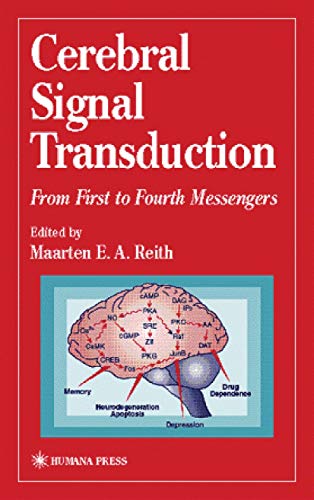cerebral signal transduction first (5 Ergebnisse)
Suchfilter
Produktart
- Alle Product Types
- Bücher (5)
- Magazine & Zeitschriften (Keine weiteren Ergebnisse entsprechen dieser Verfeinerung)
- Comics (Keine weiteren Ergebnisse entsprechen dieser Verfeinerung)
- Noten (Keine weiteren Ergebnisse entsprechen dieser Verfeinerung)
- Kunst, Grafik & Poster (Keine weiteren Ergebnisse entsprechen dieser Verfeinerung)
- Fotografien (Keine weiteren Ergebnisse entsprechen dieser Verfeinerung)
- Karten (Keine weiteren Ergebnisse entsprechen dieser Verfeinerung)
- Manuskripte & Papierantiquitäten (Keine weiteren Ergebnisse entsprechen dieser Verfeinerung)
Zustand Mehr dazu
- Neu (5)
- Wie Neu, Sehr Gut oder Gut Bis Sehr Gut (Keine weiteren Ergebnisse entsprechen dieser Verfeinerung)
- Gut oder Befriedigend (Keine weiteren Ergebnisse entsprechen dieser Verfeinerung)
- Ausreichend oder Schlecht (Keine weiteren Ergebnisse entsprechen dieser Verfeinerung)
- Wie beschrieben (Keine weiteren Ergebnisse entsprechen dieser Verfeinerung)
Einband
Weitere Eigenschaften
- Erstausgabe (Keine weiteren Ergebnisse entsprechen dieser Verfeinerung)
- Signiert (Keine weiteren Ergebnisse entsprechen dieser Verfeinerung)
- Schutzumschlag (Keine weiteren Ergebnisse entsprechen dieser Verfeinerung)
- Angebotsfoto (3)
Sprache (1)
Preis
- Beliebiger Preis
- Weniger als EUR 20 (Keine weiteren Ergebnisse entsprechen dieser Verfeinerung)
- EUR 20 bis EUR 45 (Keine weiteren Ergebnisse entsprechen dieser Verfeinerung)
- Mehr als EUR 45
Gratisversand
Land des Verkäufers
Verkäuferbewertung
-
Cerebral Signal Transduction: From First To Fourth Messengers (contemporary Neuroscience)
Anbieter: Romtrade Corp., STERLING HEIGHTS, MI, USA
Zustand: New. This is a Brand-new US Edition. This Item may be shipped from US or any other country as we have multiple locations worldwide.
-
Cerebral Signal Transduction | From First to Fourth Messengers
Anbieter: preigu, Osnabrück, Deutschland
Taschenbuch. Zustand: Neu. Cerebral Signal Transduction | From First to Fourth Messengers | Maarten E. A. Reith | Taschenbuch | xii | Englisch | 2012 | Humana | EAN 9781468496154 | Verantwortliche Person für die EU: Humana Press in Springer Science + Business Media, Heidelberger Platz 3, 14197 Berlin, juergen[dot]hartmann[at]springer[dot]com | Anbieter: preigu.
-
EUR 178,14
EUR 48,99 für den Versand von Deutschland nach USAAnzahl: Mehr als 20 verfügbar
In den WarenkorbGebunden. Zustand: New. Since the pioneering discovery of cyclic AMP four decades ago, a multitude of signaling pathways have been uncovered in which an extracellular signal (first messenger) impacts the cell surface, thereby triggering a cascade that ultimately acts on the cell n.
-
Cerebral Signal Transduction: From First to Fourth Messengers (Contemporary Neuroscience)
Anbieter: Kennys Bookstore, Olney, MD, USA
Zustand: New. The recent advent of molecular biological methodologies has generated new learning on cerebral signal transduction as it applies to the functional impact of brain events. This book highlights its role in brain processes in health and disease. Editor(s): Reith, Maarten EA (University of Illinois College of Medicine, Peoria USA). Series: Contemporary Neuroscience. Num Pages: 428 pages, 105 black & white illustrations, biography. BIC Classification: MJN. Category: (P) Professional & Vocational; (UP) Postgraduate, Research & Scholarly; (UU) Undergraduate. Dimension: 235 x 155 x 25. Weight in Grams: 797. . 2000. 2000th Edition. Hardcover. . . . . Books ship from the US and Ireland.
-
Hardcover. Zustand: Neu. Neu Neu - Neuware, Importqualität, auf Lager - Since the pioneering discovery of cyclic AMP four decades ago, a multitude of signaling pathways have been uncovered in which an extracellular signal (first messenger) impacts the cell surface, thereby triggering a cascade that ultimately acts on the cell nucleus. In each cascade the first messenger gives rise to the appearance of a second messenger such as cyclic AMP, cyclic GMP, or diacylglycerol, which in turn triggers a third messenger, a fourth messenger, and so forth. Many advances in elucidating such pathways have been made, including efforts to link messenger molecules to brain processes operative in health or disease. However, the latter type of information, relating signaling pathways to brain function, is scattered across a variety of publication media, which makes it difficult to integrate the multiple roles of different signaling cascades into our understanding of brain function in health and disease. The primary aim of Cerebral Signal Transduction: From First to Fourth Messengers, therefore, is to offer a comprehensive picture of the recent advances made in the signaling field as it relates to neuronal and cere bral function. The current state of progress provides an exciting opportunity for such a comprehensive focus because molecular tools have become available to selectively remove, reduce, or enhance spe cific components in the signaling pathways, e. g. , by interfering with the genes encoding key proteins. In addition, the increased awareness of crosstalk between different signaling cascades has revealed many possibilities for changes in gene expression underlying long-term changes in brain function.





